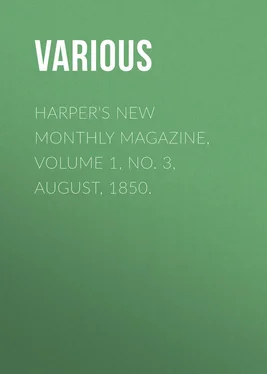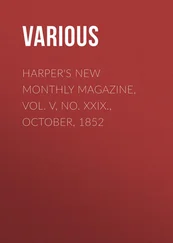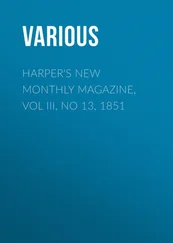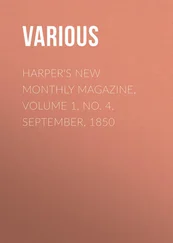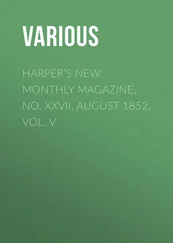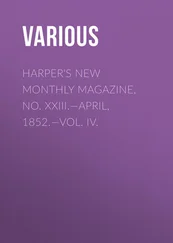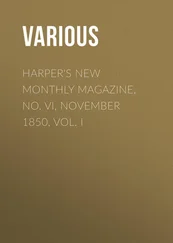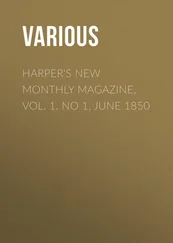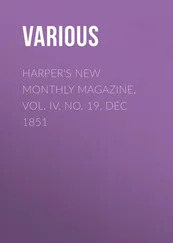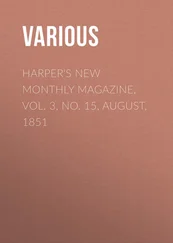Various - Harper's New Monthly Magazine, Volume 1, No. 3, August, 1850.
Здесь есть возможность читать онлайн «Various - Harper's New Monthly Magazine, Volume 1, No. 3, August, 1850.» — ознакомительный отрывок электронной книги совершенно бесплатно, а после прочтения отрывка купить полную версию. В некоторых случаях можно слушать аудио, скачать через торрент в формате fb2 и присутствует краткое содержание. Издательство: Иностранный паблик, Жанр: periodic, foreign_edu, на английском языке. Описание произведения, (предисловие) а так же отзывы посетителей доступны на портале библиотеки ЛибКат.
- Название:Harper's New Monthly Magazine, Volume 1, No. 3, August, 1850.
- Автор:
- Издательство:Иностранный паблик
- Жанр:
- Год:неизвестен
- ISBN:нет данных
- Рейтинг книги:5 / 5. Голосов: 1
-
Избранное:Добавить в избранное
- Отзывы:
-
Ваша оценка:
- 100
- 1
- 2
- 3
- 4
- 5
Harper's New Monthly Magazine, Volume 1, No. 3, August, 1850.: краткое содержание, описание и аннотация
Предлагаем к чтению аннотацию, описание, краткое содержание или предисловие (зависит от того, что написал сам автор книги «Harper's New Monthly Magazine, Volume 1, No. 3, August, 1850.»). Если вы не нашли необходимую информацию о книге — напишите в комментариях, мы постараемся отыскать её.
Harper's New Monthly Magazine, Volume 1, No. 3, August, 1850. — читать онлайн ознакомительный отрывок
Ниже представлен текст книги, разбитый по страницам. Система сохранения места последней прочитанной страницы, позволяет с удобством читать онлайн бесплатно книгу «Harper's New Monthly Magazine, Volume 1, No. 3, August, 1850.», без необходимости каждый раз заново искать на чём Вы остановились. Поставьте закладку, и сможете в любой момент перейти на страницу, на которой закончили чтение.
Интервал:
Закладка:
Cuvier could not refrain from feelings of admiration, and was somewhat affected when he saw the mother, with indefatigable patience and grace, show her children how they should set about catching flies, which darted about in the air – to suck in an incautious one, or carry away a spider which had imprudently made his net between the branches of two trees. Often she would hold out to them at a distance in her beak a booty which excited their appetite; then she would go away by degrees, and gradually draw them unconsciously off to a shorter or a longer distance from the nest. The swallow taught her children to fly high when the air was calm, for then the insects kept in a more elevated part of the air; or to skim along the ground at the approach of a storm, as then the same insects would direct their course toward the earth, where they might find shelter under the stones at the fall of the first drop of rain. Then the little ones, more experienced, began, under the guidance of their father, to undertake longer flights. The mother, standing at the entrance of the nest, seemed to give her instructions before they departed: she awaited their return with anxiety, and when that was delayed, took a flight high, very high in the air, and there flew to and fro till she saw them. Then, full of a mother's joy, she would utter cries of emotion, scud before them, bring them back to the nest, happy and palpitating, and seemed to demand an account of the causes of their delay.
The autumn arrived. Some groups of swallows collected together on the very roof of the mansion of Fiquanville. After grave deliberation, and a vote being taken (whether by ballot or otherwise, Cuvier does not mention), the young ones of the nest, along with the other young swallows of the same age, were all placed in the middle of the troop; and one morning a living cloud rose above the chateau, and flew away swiftly due east.
The following spring two swallows, worn down by fatigue, came to take possession of the nest. Cuvier recognized them immediately; they were the very same – those whose manners and habits he had studied the preceding year. They proceeded to restore the nest, cracked and injured in some places by the frost: they garnished anew the inside with fresh feathers and choice moss, then, as last year, made an excursion of some days. On the very morrow after their return, while they were darting to and fro close to Cuvier's window, to whose presence they had become accustomed, and which did not in the least incommode them, a screech-owl, that seemed to fall from above, pounced upon the male, seized him in his talons, and was already bearing him away, when Cuvier took down his gun, which was within reach, primed and cocked it, and fired at the owl; the fellow, mortally wounded, fell head over heels into the garden, and Cuvier hastened to deliver the swallow from the claws of the dead owl, who still held him with his formidable nails. The poor swallow had received some deep wounds; the nails of the owl had penetrated deeply into his side, and one of the drops of shot had broken his leg. Cuvier dressed the wounds as well as he could, and, by the aid of a ladder, replaced the invalid in his nest, while the female flew sadly around it, uttering cries of despair. For three or four days she never left the nest but to go in search of food, which she offered the male. Cuvier saw his sickly head come out with difficulty, and try in vain to take the food offered by his companion; every day he appeared to get weaker. At length, one morning, Cuvier was awakened by the cries of the female, who with her wings beat against the panes of his window. He ran to the nest – alas! it contained only a dead body. From that fatal moment the female never left her nest. Overwhelmed with grief, she, five days after, died of despair, on the dead body of her companion.
Some months after this, the Abbé Tessier, whom the revolutionary persecution had compelled to flee to Normandy, where he disguised himself under the dress of a military physician of the hospital of Fécamp, fell in with the obscure tutor, who recounted to him the history of the swallows. The abbé engaged him to deliver a course of lectures on natural history to the pupils of that hospital, of which he was the head, and wrote to Jussieu and Geoffrey Saint Hilaire, to inform them of the individual he had become acquainted with. Cuvier entered into a correspondence with these two learned men, and a short time after he was elected to the chair of comparative anatomy at Paris His subsequent career is well known.
A GIRAFFE CHASE
This day was to me rather a memorable one, as the first on which I saw and slew the lofty, graceful-looking giraffe or camelopard, with which, during many years of my life, I had longed to form an acquaintance. These gigantic and exquisitely beautiful animals, which are admirably formed by nature to adorn the fair forests that clothe the boundless plains of the interior, are widely distributed throughout the interior of Southern Africa, but are nowhere to be met with in great numbers. In countries unmolested by the intrusive foot of man, the giraffe is found generally in herds varying from twelve to sixteen; but I have not unfrequently met with herds containing thirty individuals, and on one occasion I counted forty together; this, however, was owing to chance, and about sixteen maybe reckoned as the average number of a herd. These herds are composed of giraffes of various sizes, from the young giraffe of nine or ten feet in height, to the dark, chestnut-colored old bull of the herd, whose exalted head towers above his companions, generally attaining to a height of upward of eighteen feet. The females are of lower stature and more delicately formed than the males, their height averaging from sixteen to seventeen feet. Some writers have discovered ugliness and a want of grace in the giraffe, but I consider that he is one of the most strikingly beautiful animals in the creation; and when a herd of them is seen scattered through a grove of the picturesque parasol-topped acacias which adorn their native plains, and on whose uppermost shoots they are enabled to browse by the colossal height with which nature has so admirably endowed them, he must, indeed, be slow of conception who fails to discover both grace and dignity in all their movements. There can be no doubt, that every animal is seen to the greatest advantage in the haunts which nature destined him to adorn; and among the various living creatures which beautify this fair creation I have often traced a remarkable resemblance between the animal and the general appearance of the locality in which it is found. This I first remarked at an early period of my life, when entomology occupied a part of my attention No person following this interesting pursuit can fail to observe the extraordinary likeness which insects bear to the various abodes in which they are met with. Thus, among the long green grass we find a variety of long green insects, whose legs and antennæ so resemble the shoots emanating from the stalks of the grass that it requires a practiced eye to distinguish them. Throughout sandy districts varieties of insects are met with of a color similar to the sand which they inhabit. Among the green leaves of the various trees of the forest innumerable leaf-colored insects are to be found; while, closely adhering to the rough gray bark of these forest-trees, we observe beautifully-colored, gray-looking; moths of various patterns, yet altogether so resembling the bark as to be invisible to the passing observer. In like manner among quadrupeds I have traced a corresponding analogy, for, even in the case of the stupendous elephant, the ashy color of his hide so corresponds with the general appearance of the gray thorny jungles which he frequents throughout the day, that a person unaccustomed to hunting elephants, standing on a commanding situation, might look down upon a herd and fail to detect their presence. And further, in the case of the giraffe, which is invariably met with among venerable forests, where innumerable blasted and weather-beaten trunks and stems occur, I have repeatedly been in doubt as to the presence of a troop of them until I had recourse to my spy-glass; and on referring the case to my savage attendants, I have known even their optics to fail, at one time mistaking these dilapidated trunks for camelopards, and again confounding real camelopards with these aged veterans of the forest.
Читать дальшеИнтервал:
Закладка:
Похожие книги на «Harper's New Monthly Magazine, Volume 1, No. 3, August, 1850.»
Представляем Вашему вниманию похожие книги на «Harper's New Monthly Magazine, Volume 1, No. 3, August, 1850.» списком для выбора. Мы отобрали схожую по названию и смыслу литературу в надежде предоставить читателям больше вариантов отыскать новые, интересные, ещё непрочитанные произведения.
Обсуждение, отзывы о книге «Harper's New Monthly Magazine, Volume 1, No. 3, August, 1850.» и просто собственные мнения читателей. Оставьте ваши комментарии, напишите, что Вы думаете о произведении, его смысле или главных героях. Укажите что конкретно понравилось, а что нет, и почему Вы так считаете.
